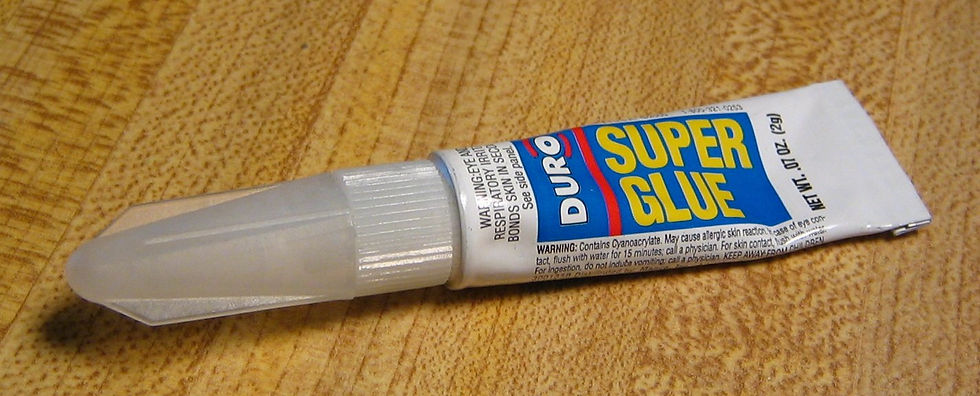5 Best Wood Glues You Need to Know in Woodworking
- Luca Dal Molin
- Jun 14, 2023
- 8 min read
As a self-taught hobbyist, I remember very well my first days of woodworking, when I considered glue just like a necessary medium to connect two pieces of wood.
The thing was, any type of glue I would be told about was the same for me as long as it would get the job done. But the reality is a little bit more complex and, in woodworking, like in any other activities where glue is involved, there is a specific glue for a specific task.

In this article, we will explore the top 5 most used types of glue and why they are so popular in woodworking. The last one is probably the less known and not common to find in another blog post. Still, it's worth discussing it as it might find useful applications, especially regarding repairs and restoration. So, stay tuned till the end of the article!
Here are the 5 types of glue:
Glue is deeply connected to woodworking, and it has always been; the first evidence goes back to the Egyptians, and, most likely, the use of glue with wood was much further back in antiquity.
At that time, modern synthetic glues were not available, and adhesives originated from plants and animals. The most common glues were obtained from skin, bones and fish residues; then there was the blood, which was from the raw blood from slaughterhouses, and finally, the casein, derived from an animal milk protein
It was only in the mid-20th century that the first modern wood glues appeared on the market, and with that, a lot changed for the good in terms of easiness of application and durability. These modern glues are produced by chemical synthesis, are easy to use and have a longer shelf life.
"modern wood glues are very strong"
Another important aspect to notice is that modern wood glues are very strong! To what extent, you might ask? Well, to the point that, after several stress tests on two parts of wood glued together, the first points of failure affect the fibres of the wood and not the glue itself. Interesting, isn’t it? It is, and the secret behind this strength is in the wetness of the surfaces; in fact, good wood bonding requires the surfaces to be joined to be wet, then solidify and create a strong bonded joint.
1. PVA GLUE

PVA is the acronym for Polyvinyl Acetate and one of the most popular woodworking glues in the market. Of white or yellow colour, it’s suitable for many tasks, from glueing parts of solid wood to wood veneering or laminating.
This has always been considered "the glue" for me, the most recognized and used since childhood. No glue is probably more versatile than the PVA and finds application in so many different circumstances. And on top of that, it is very easy to apply and not as messy as other glues.
"PVA glue has reduced open times"
Even if sometimes overlooked, the best temperature for applying the PVA is around 20 degrees, a common temperature in most of our workshops.
It has an open time of around 5 minutes, sometimes more, depending on the brand and the specifics. Because of this available short time, some glue-ups can become a bit stressful and push you to speed up. Consequently, you might incur the risk of not checking the proper alignment of all the parts, with consequent problems in terms of the precision of the construction.
Now, you might wonder, what is the open time? As the words say, the open time is considered for glue, the available time you have to bond to parts together before the glue starts creating a skin that you can’t bond to.
Another characteristic of the PVA, unknown to most, is that it’s a thermoplastic and tends to soften when exposed to higher temperatures. This can come in our favour because it takes around 24h to set completely, and during this time, the glue offers some sort of reversibility. This can be particularly useful in veneering where, for example, a glue-up of a panel didn’t succeed completely.
In this case, it is possible to apply some heat to the part where the glue needs to be reactivated and fix the issue. This is generally achieved with the use of an iron.
Modern PVA glues come for different use,s and it’s quite common to find water-resistant and waterproof adhesives. Before you get involved in a project, consider the environment where your piece will find a place and choose the right glue.
For example, Titebond, one of the most popular adhesive brands, offers several types of PVA, the most common being Titebond Original, Titebond II and Titebond III. But it's not the only brand available on the market; during my studies in Scotland, I successfully used Adkwik with excellent results.

What should I say about this glue..it saved me in so many situations! It's never a walk in the park when you make a piece of furniture, and even the most beautiful ones, at some point, require some minor (or major!) repair to be done.
And this is where the Super Glue helps a lot of woodworkers.
Cyanoacrylate (CA) glue is another name for the Super Glue, and I'm pretty sure you have some in one of your drawers in the office or in the kitchen.
"CA glues is excellent for fast glue ups"
Opposite to the PVA glue, its main purpose is not to make long-lasting and strong bonds on large surfaces but to provide fast glue-ups. In fact, the Super Glue sets in a matter of seconds (so it doesn't require clamping) and is widely used not only for small repairs but also in making jigs to hold pieces together.
Cool, isn't it? And that's not all; It is also sometimes used to fill small dents as it is invisible to the eye once cured (I learned this tip from Scott Grove, a great woodworker and my tutor during my time spent at school).
But mind your wallet and use it where appropriate; it is quite expensive and can easily break apart, as it is not very resistant to shear force.
I don't have a particular brand to recommend, as most of them are similar and offer the same results for the tasks I described. I used the Mitre Fast with its activator a lot, and I never had a problem with that.

Wooow! What glue! Ok, now you might say that I get easily excited with glues but believe me, this is another incredible adhesive, and it proved to be the best for the job I used it for, in this case, to laminate strips of oak when I made my lounge chair.
Since its first introduction in late 1930, this adhesive has been popular among woodworkers for its durability and gap-filling properties. Once cured, it offers a very strong bond, even better than PVA. It’s used for laminations, joints and veneers; it can be used in a vacuum bag or applied with clamps. See the versatility?
"I found this glue quite easy to use with some precautions"
Back to my lounge chair, particularly to the lamination of the armrest, it was the first time I got to know this glue. Nevertheless, I found it quite easy to use with the use of some precautions. In fact, it is mandatory that you use disposable gloves when you mix and apply it because, if it sticks to your skin, it can be more difficult to remove than the PVA.
The glue I used is One Shot, produced by Adkwik. It comes in powder, and it’s diluted with water. It has a very long open time, I would say a minimum of one hour, so I didn’t have to rush in clamping the laminations (it was already challenging like this...). I could put more attention and care into aligning the individual strips of wood.
On the other side, this glue needs a much longer clamping time, up to 6-8 hours, to ensure that the glue sets properly, so I used to leave it overnight to be safe. Then, once the glue is completely dry, the lines are generally invisible and give an excellent aesthetic result
4. HOT GLUE

What has this arts and craft glue has to do with woodworking? How can it be considered practical and competitive against the above-mentioned glues?
I remember seeing my mom making some felt and cardboard crafts a few years ago, and it was so practical to use some hot glue to bond the parts together. But only last year I realized that hot glue could find its little—niche in woodworking.
"Hot glue is sold in sticks and melted with an electric gun"
The hot glue is sold in sticks that get hot and melted using an electric gun that dispenses the material from its tip. For this reason, you want to be careful not to let it touch your fingers when you apply, as it can be a bit painful.
In woodworking is used to temporarily bond parts together, to keep them in position before, for example, drilling holes for screws. The first to show me was Michael Fortune, who taught us about bending laminations. He was building a jig on the spot when he said, "..ok, guys, now I will stick the two parts with some hot glue". Hot glue?? And it worked perfectly.
It was so good that I used it on other occasions. One handy use was when I had to position the hinges on the doors of my Krenov cabinet. Fixing them in position with some hot glue made the task of drilling the holes for the screws go like a breeze.

And here we are at our last glue. Shall I call it glue? Or just sealant...I honestly don't know, so I name it directly from its branded name. Produced by Captain Tolley's, it's definitely an interesting product to be aware of and that most of the woodworkers have never heard about.
Created originally for the boating industry, this sealant is thin as water works by capillarity and has a great penetrating effect. If applied on cracks less than 0.8 mm wide, it strongly bonds the parts together and recreates the original strength of the wood fibres.
It's easy now to think of all those situations where this glue can come in handy: small cracks in the wood fibres, restoration works, and all situations where this sealant can be successfully used.
"It can be successfully used in restoration"
My main usage of the Creeping Crack Cure was during a restoration project where an old mahogany table had several leg cracks that would have required a full replacement of the parts. Since the client didn't want to invest too much in the repairs, it was decided to use this glue where possible. The final result was surprisingly good, which is why I believe this sealant should definitely find its place on every woodworker's shelf!
CONCLUSION
In this post, we looked at the most popular and useful glues that every woodworker should know. Each of them has a specific use and can complement each other. Are all of them indispensable? Probably not, and you could survive with some good PVA and maybe the CA glue. But it's worth knowing about other products because, as our woodworking skills evolve, selecting the right glue for a specific job might be necessary.
At Dubai Makers Society, we have all these glues and can teach you how to use them correctly.
And you..did you know already all these types of glues, or is this the first time?
If you love woodworking as we do, join our community by subscribing to our mailing list. All our latest news and fresh new blog post are in your mailbox every week.






Comments